Analyzing a Cohort Study: Using the CASP Checklist for Evaluation
VerifiedAdded on 2023/06/03
|7
|1377
|433
Homework Assignment
AI Summary
This document presents a completed Critical Appraisal Skills Programme (CASP) checklist, used to evaluate the validity, results, and applicability of a cohort study. The checklist systematically addresses key aspects of the study, including the clarity of the research question, the recruitment of the cohort, the accuracy of exposure and outcome measurements, the consideration of confounding factors, the completeness and duration of follow-up, and the precision of the results. The analysis also considers whether the results can be applied to a local population and how they align with other available evidence. The CASP checklist is a structured tool designed to help users assess the strengths and weaknesses of a cohort study, enabling a more informed interpretation of the research findings and their potential implications for practice. The document includes detailed comments and responses for each question of the checklist, offering a comprehensive evaluation of the study's methodology and findings.
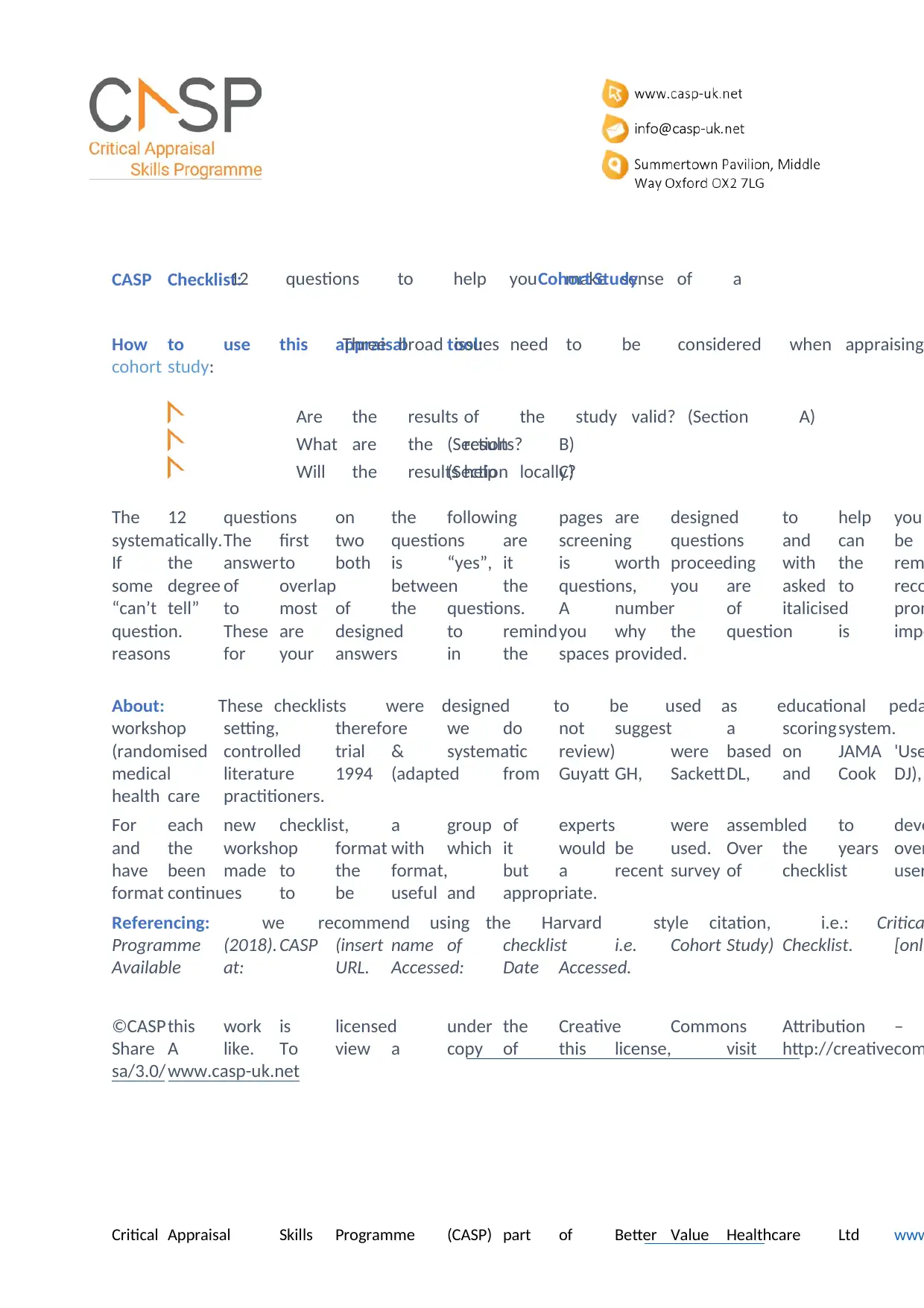
Critical Appraisal Skills Programme (CASP) part of Better Value Healthcare Ltd www
CASP Checklist:12 questions to help you make sense of aCohort Study
How to use this appraisal tool:Three broad issues need to be considered when appraising
cohort study:
Are the results of the study valid? (Section A)
What are the results?(Section B)
Will the results help locally?(Section C)
The 12 questions on the following pages are designed to help you
systematically.The first two questions are screening questions and can be
If the answerto both is “yes”, it is worth proceeding with the rem
some degree of overlap between the questions, you are asked to reco
“can’t tell” to most of the questions. A number of italicised prom
question. These are designed to remindyou why the question is impo
reasons for your answers in the spaces provided.
About: These checklists were designed to be used as educational peda
workshop setting, therefore we do not suggest a scoringsystem.
(randomised controlled trial & systematic review) were based on JAMA 'Use
medical literature 1994 (adapted from Guyatt GH, SackettDL, and Cook DJ),
health care practitioners.
For each new checklist, a group of experts were assembled to deve
and the workshop format with which it would be used. Over the years over
have been made to the format, but a recent survey of checklist user
format continues to be useful and appropriate.
Referencing: we recommend using the Harvard style citation, i.e.: Critica
Programme (2018). CASP (insert name of checklist i.e. Cohort Study) Checklist. [onli
Available at: URL. Accessed: Date Accessed.
©CASPthis work is licensed under the Creative Commons Attribution –
Share A like. To view a copy of this license, visit http://creativecom
sa/3.0/www.casp-uk.net
CASP Checklist:12 questions to help you make sense of aCohort Study
How to use this appraisal tool:Three broad issues need to be considered when appraising
cohort study:
Are the results of the study valid? (Section A)
What are the results?(Section B)
Will the results help locally?(Section C)
The 12 questions on the following pages are designed to help you
systematically.The first two questions are screening questions and can be
If the answerto both is “yes”, it is worth proceeding with the rem
some degree of overlap between the questions, you are asked to reco
“can’t tell” to most of the questions. A number of italicised prom
question. These are designed to remindyou why the question is impo
reasons for your answers in the spaces provided.
About: These checklists were designed to be used as educational peda
workshop setting, therefore we do not suggest a scoringsystem.
(randomised controlled trial & systematic review) were based on JAMA 'Use
medical literature 1994 (adapted from Guyatt GH, SackettDL, and Cook DJ),
health care practitioners.
For each new checklist, a group of experts were assembled to deve
and the workshop format with which it would be used. Over the years over
have been made to the format, but a recent survey of checklist user
format continues to be useful and appropriate.
Referencing: we recommend using the Harvard style citation, i.e.: Critica
Programme (2018). CASP (insert name of checklist i.e. Cohort Study) Checklist. [onli
Available at: URL. Accessed: Date Accessed.
©CASPthis work is licensed under the Creative Commons Attribution –
Share A like. To view a copy of this license, visit http://creativecom
sa/3.0/www.casp-uk.net
Paraphrase This Document
Need a fresh take? Get an instant paraphrase of this document with our AI Paraphraser
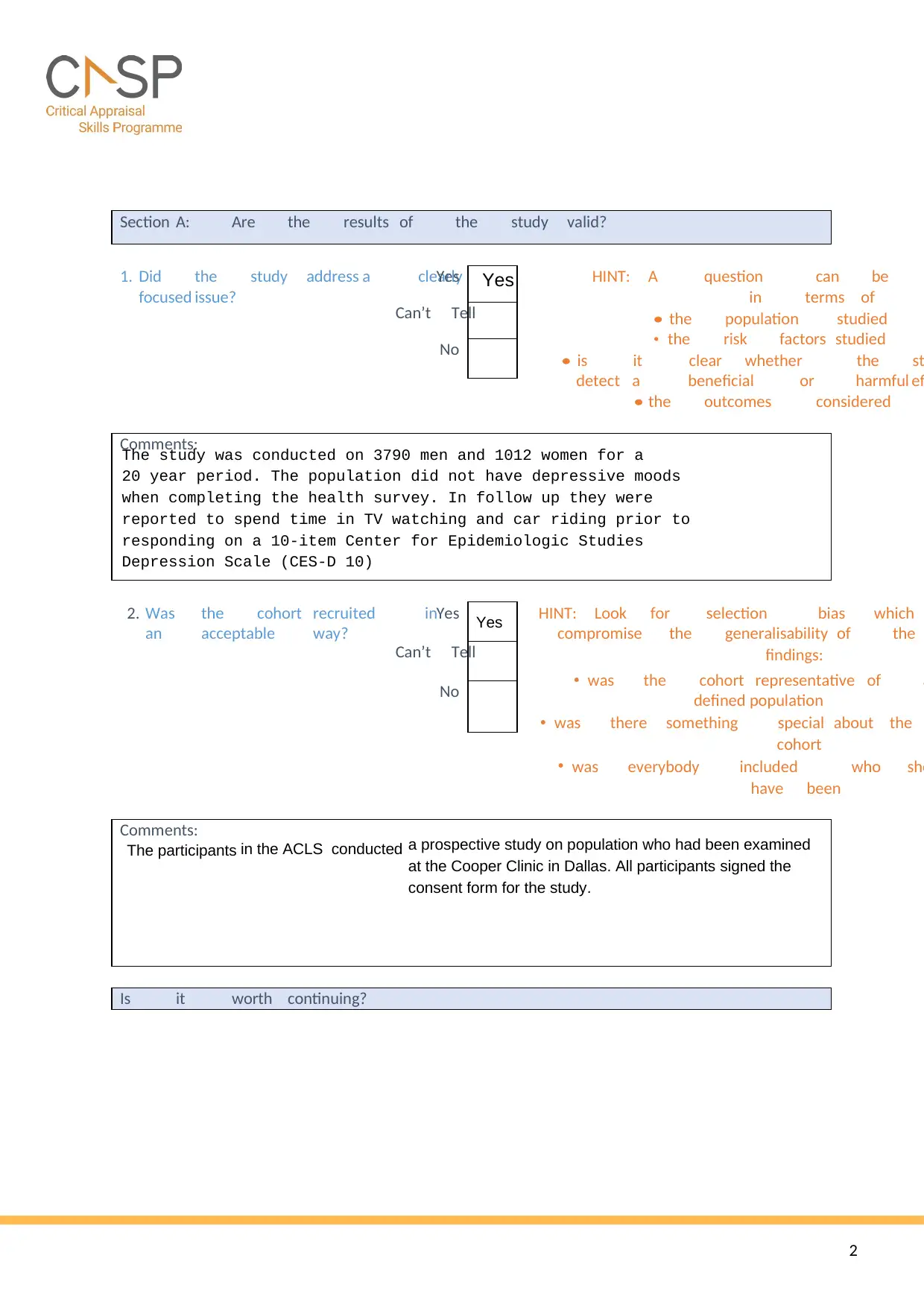
2
Section A: Are the results of the study valid?
1. Did the study address a clearly
focused issue?
Yes HINT: A question can be
in terms of
• the population studied
• the risk factors studied
• is it clear whether the st
detect a beneficial or harmful eff
• the outcomes considered
Can’t Tell
No
Comments:
2. Was the cohort recruited in
an acceptable way?
Yes HINT: Look for selection bias which
compromise the generalisability of the
findings:
• was the cohort representative of a
defined population
• was there something special about the
cohort
• was everybody included who sho
have been
Can’t Tell
No
Comments:
Is it worth continuing?
Yes
The study was conducted on 3790 men and 1012 women for a
20 year period. The population did not have depressive moods
when completing the health survey. In follow up they were
reported to spend time in TV watching and car riding prior to
responding on a 10-item Center for Epidemiologic Studies
Depression Scale (CES-D 10)
Yes
The participants in the ACLS conducted a prospective study on population who had been examined
at the Cooper Clinic in Dallas. All participants signed the
consent form for the study.
Section A: Are the results of the study valid?
1. Did the study address a clearly
focused issue?
Yes HINT: A question can be
in terms of
• the population studied
• the risk factors studied
• is it clear whether the st
detect a beneficial or harmful eff
• the outcomes considered
Can’t Tell
No
Comments:
2. Was the cohort recruited in
an acceptable way?
Yes HINT: Look for selection bias which
compromise the generalisability of the
findings:
• was the cohort representative of a
defined population
• was there something special about the
cohort
• was everybody included who sho
have been
Can’t Tell
No
Comments:
Is it worth continuing?
Yes
The study was conducted on 3790 men and 1012 women for a
20 year period. The population did not have depressive moods
when completing the health survey. In follow up they were
reported to spend time in TV watching and car riding prior to
responding on a 10-item Center for Epidemiologic Studies
Depression Scale (CES-D 10)
Yes
The participants in the ACLS conducted a prospective study on population who had been examined
at the Cooper Clinic in Dallas. All participants signed the
consent form for the study.
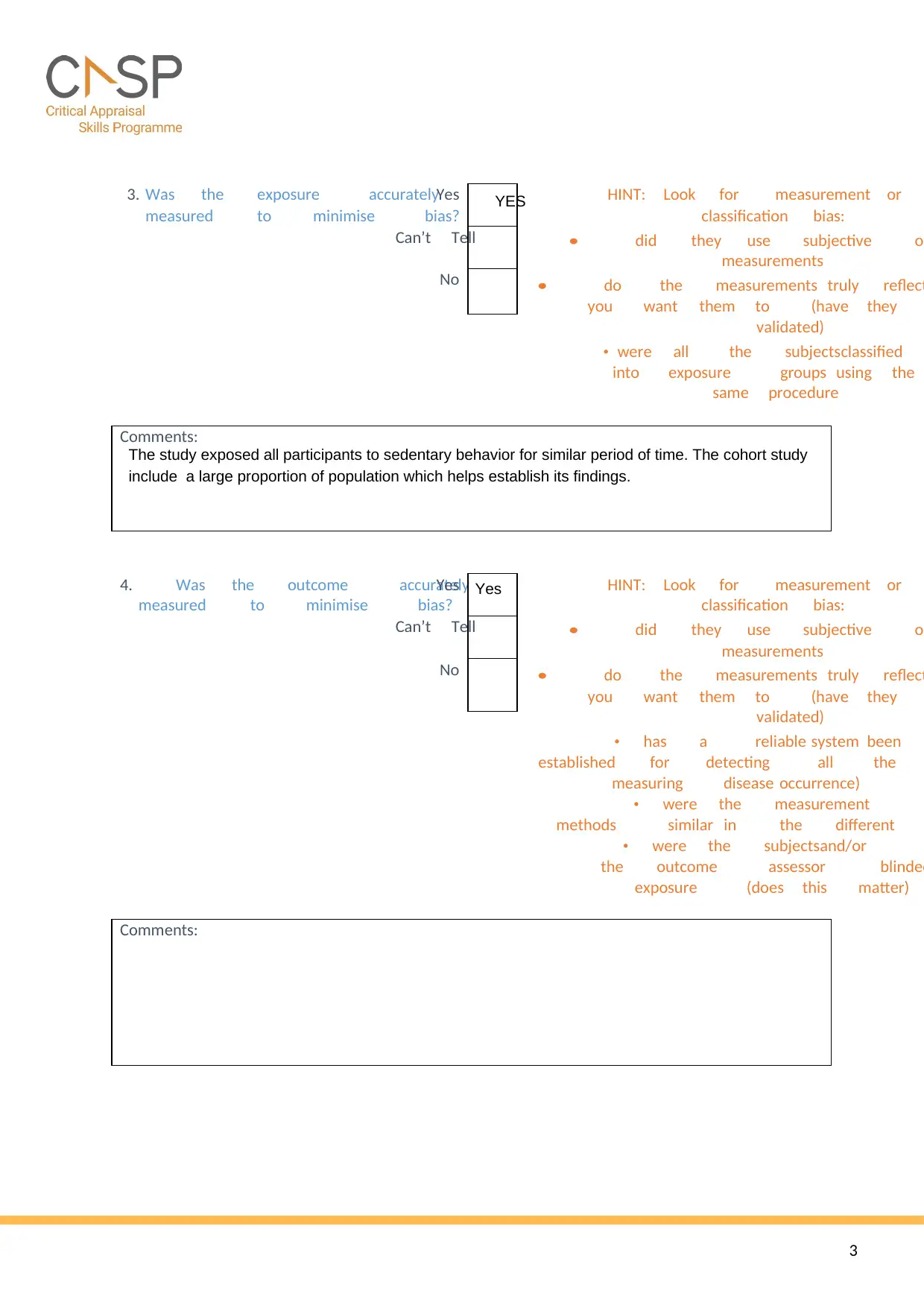
3
3. Was the exposure accurately
measured to minimise bias?
Yes HINT: Look for measurement or
classification bias:
• did they use subjective or
measurements
• do the measurements truly reflect
you want them to (have they b
validated)
• were all the subjectsclassified
into exposure groups using the
same procedure
Can’t Tell
No
Comments:
4. Was the outcome accurately
measured to minimise bias?
Yes HINT: Look for measurement or
classification bias:
• did they use subjective or
measurements
• do the measurements truly reflect
you want them to (have they b
validated)
• has a reliable system been
established for detecting all the
measuring disease occurrence)
• were the measurement
methods similar in the different
• were the subjectsand/or
the outcome assessor blinded
exposure (does this matter)
Can’t Tell
No
Comments:
YES
The study exposed all participants to sedentary behavior for similar period of time. The cohort study
include a large proportion of population which helps establish its findings.
Yes
3. Was the exposure accurately
measured to minimise bias?
Yes HINT: Look for measurement or
classification bias:
• did they use subjective or
measurements
• do the measurements truly reflect
you want them to (have they b
validated)
• were all the subjectsclassified
into exposure groups using the
same procedure
Can’t Tell
No
Comments:
4. Was the outcome accurately
measured to minimise bias?
Yes HINT: Look for measurement or
classification bias:
• did they use subjective or
measurements
• do the measurements truly reflect
you want them to (have they b
validated)
• has a reliable system been
established for detecting all the
measuring disease occurrence)
• were the measurement
methods similar in the different
• were the subjectsand/or
the outcome assessor blinded
exposure (does this matter)
Can’t Tell
No
Comments:
YES
The study exposed all participants to sedentary behavior for similar period of time. The cohort study
include a large proportion of population which helps establish its findings.
Yes
⊘ This is a preview!⊘
Do you want full access?
Subscribe today to unlock all pages.

Trusted by 1+ million students worldwide
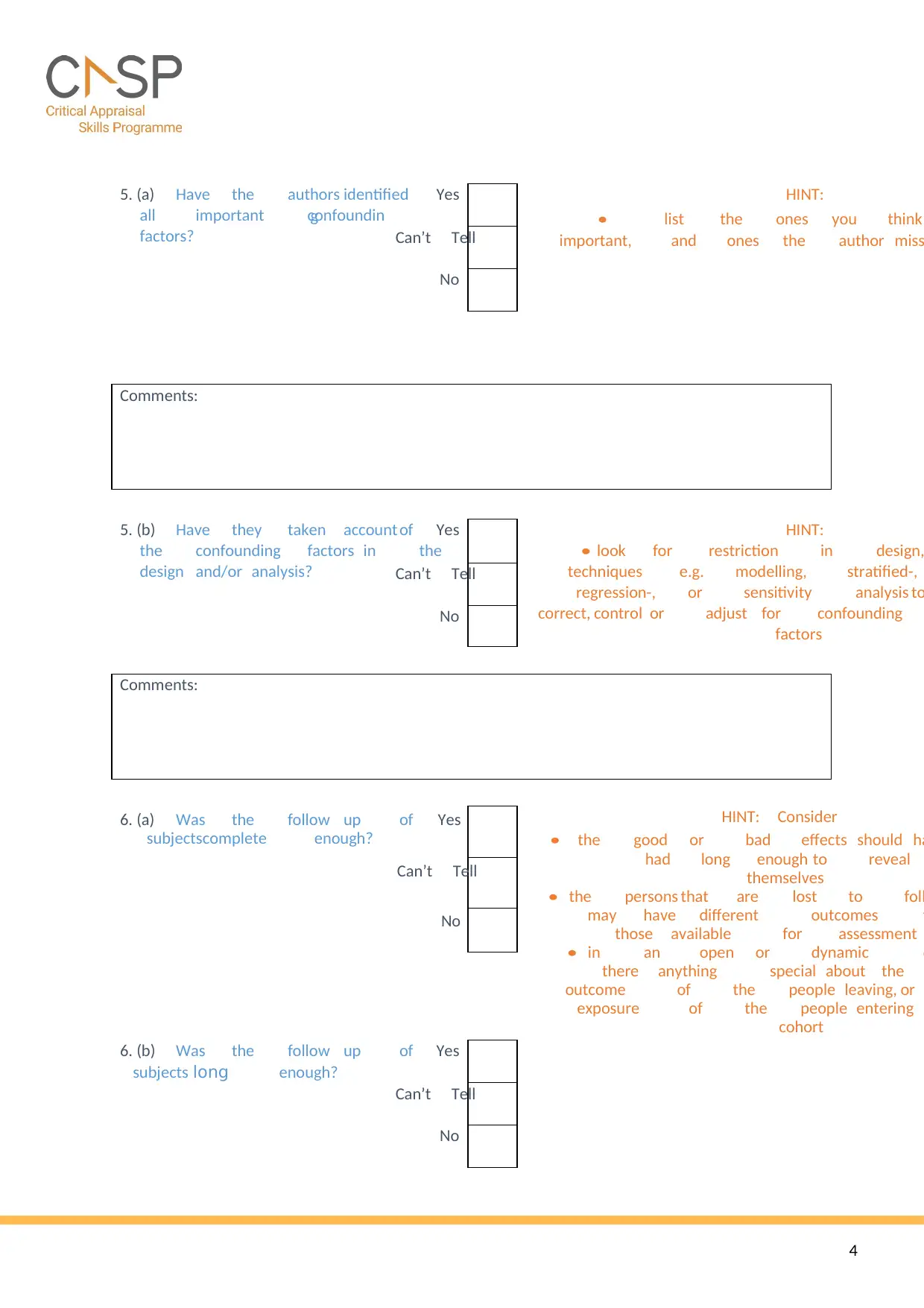
4
5. (a) Have the authors identified
all important confounding
factors?
Yes HINT:
• list the ones you think
important, and ones the author missCan’t Tell
No
Comments:
5. (b) Have they taken account of
the confounding factors in the
design and/or analysis?
Yes HINT:
• look for restriction in design,
techniques e.g. modelling, stratified-,
regression-, or sensitivity analysis to
correct, control or adjust for confounding
factors
Can’t Tell
No
Comments:
6. (a) Was the follow up of
subjectscomplete enough?
Yes HINT: Consider
• the good or bad effects should ha
had long enough to reveal
themselves
• the persons that are lost to foll
may have different outcomes t
those available for assessment
• in an open or dynamic c
there anything special about the
outcome of the people leaving, or
exposure of the people entering
cohort
Can’t Tell
No
6. (b) Was the follow up of
subjects long enough?
Yes
Can’t Tell
No
5. (a) Have the authors identified
all important confounding
factors?
Yes HINT:
• list the ones you think
important, and ones the author missCan’t Tell
No
Comments:
5. (b) Have they taken account of
the confounding factors in the
design and/or analysis?
Yes HINT:
• look for restriction in design,
techniques e.g. modelling, stratified-,
regression-, or sensitivity analysis to
correct, control or adjust for confounding
factors
Can’t Tell
No
Comments:
6. (a) Was the follow up of
subjectscomplete enough?
Yes HINT: Consider
• the good or bad effects should ha
had long enough to reveal
themselves
• the persons that are lost to foll
may have different outcomes t
those available for assessment
• in an open or dynamic c
there anything special about the
outcome of the people leaving, or
exposure of the people entering
cohort
Can’t Tell
No
6. (b) Was the follow up of
subjects long enough?
Yes
Can’t Tell
No
Paraphrase This Document
Need a fresh take? Get an instant paraphrase of this document with our AI Paraphraser
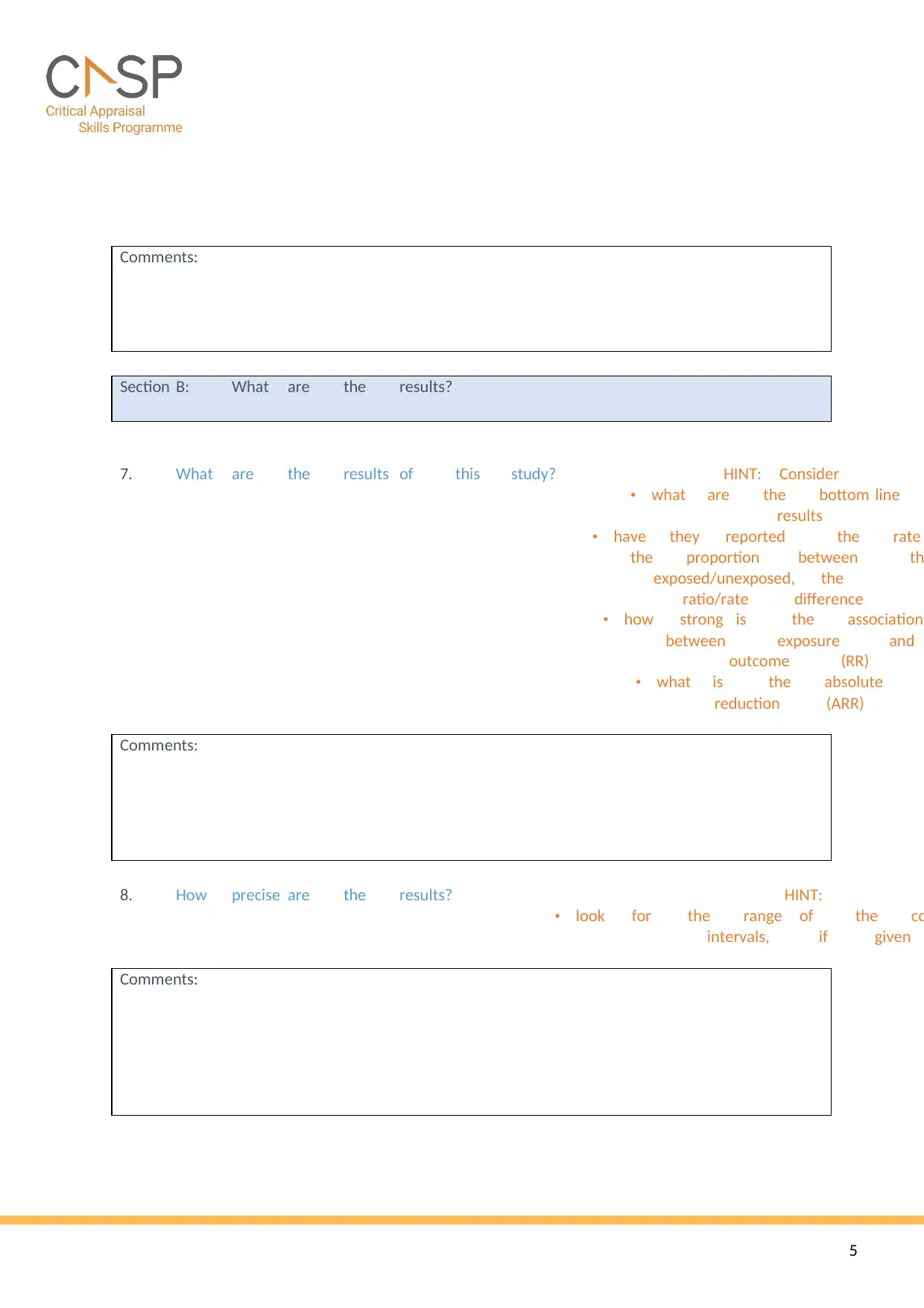
5
Comments:
Section B: What are the results?
7. What are the results of this study? HINT: Consider
• what are the bottom line
results
• have they reported the rate
the proportion between th
exposed/unexposed, the
ratio/rate difference
• how strong is the association
between exposure and
outcome (RR)
• what is the absolute
reduction (ARR)
Comments:
8. How precise are the results? HINT:
• look for the range of the co
intervals, if given
Comments:
Comments:
Section B: What are the results?
7. What are the results of this study? HINT: Consider
• what are the bottom line
results
• have they reported the rate
the proportion between th
exposed/unexposed, the
ratio/rate difference
• how strong is the association
between exposure and
outcome (RR)
• what is the absolute
reduction (ARR)
Comments:
8. How precise are the results? HINT:
• look for the range of the co
intervals, if given
Comments:

6
9. Do you believe the results?Yes HINT: Consider
• big effect is hard to i
• can it be due to bias,
confounding
• are the design and methods o
study sufficiently flawed to make the
results unreliable
• Bradford Hills criteria (e.g. time
sequence, dose-response gradient,
biological plausibility, consistency)
Can’t Tell
No
Comments:
Section C: Will the results help locally?
10. Can the results be applied to
the local population?
Yes HINT: Consider whether
• a cohort study was the appropria
method to answer this question
• the subjectscoveredin this study could
be sufficiently different from
population to cause concern
• your local setting is likely to
much from that of the stu
• you can quantify the local bene
harms
Can’t Tell
No
Comments:
11. Do the results of this study fit
with other available
evidence?
Yes
Can’t Tell
No
Comments:
9. Do you believe the results?Yes HINT: Consider
• big effect is hard to i
• can it be due to bias,
confounding
• are the design and methods o
study sufficiently flawed to make the
results unreliable
• Bradford Hills criteria (e.g. time
sequence, dose-response gradient,
biological plausibility, consistency)
Can’t Tell
No
Comments:
Section C: Will the results help locally?
10. Can the results be applied to
the local population?
Yes HINT: Consider whether
• a cohort study was the appropria
method to answer this question
• the subjectscoveredin this study could
be sufficiently different from
population to cause concern
• your local setting is likely to
much from that of the stu
• you can quantify the local bene
harms
Can’t Tell
No
Comments:
11. Do the results of this study fit
with other available
evidence?
Yes
Can’t Tell
No
Comments:
⊘ This is a preview!⊘
Do you want full access?
Subscribe today to unlock all pages.

Trusted by 1+ million students worldwide

7
12. What are the implications of
this study for practice?
Yes HINT: Consider
• one observational study rarely
provides sufficiently robust
evidence to recommend changes
to clinical practiceor within health
policy decision making
• for certain questions,
observational studies provide the
only evidence
• recommendations from
observational studies are always
stronger when supported by o
evidence
Can’t Tell
No
Comments:
12. What are the implications of
this study for practice?
Yes HINT: Consider
• one observational study rarely
provides sufficiently robust
evidence to recommend changes
to clinical practiceor within health
policy decision making
• for certain questions,
observational studies provide the
only evidence
• recommendations from
observational studies are always
stronger when supported by o
evidence
Can’t Tell
No
Comments:
1 out of 7
Related Documents
Your All-in-One AI-Powered Toolkit for Academic Success.
+13062052269
info@desklib.com
Available 24*7 on WhatsApp / Email
![[object Object]](/_next/static/media/star-bottom.7253800d.svg)
Unlock your academic potential
Copyright © 2020–2025 A2Z Services. All Rights Reserved. Developed and managed by ZUCOL.




